 The University of Chicago Magazine June 1995
The University of Chicago Magazine June 1995
Return to June 1995 Table of Contents
INVESTIGATIONS
Also in this deparment: the Internet wisdom of FAQs, the importance of the Illinois & Michigan Canal, dinosaur extinctions, the ethics of genetics, and research Citations.
Kris Hammond turns the Internet's "frequently asked questions" into a
wealth of easy answers.
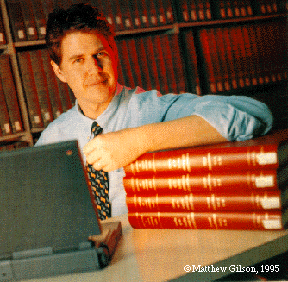 The facts at hand: Kris Hammond's new program puts Internet wisdom within reach.
The facts at hand: Kris Hammond's new program puts Internet wisdom within reach.
IF YOU WANT ANSWERS in a hurry, the Internet's broad resources are often no
better than an electronic Tower of Babel. Tools like Gopher servers, the
World Wide Web, and the public bulletin boards called newsgroups organize
information by totally different schemes, and there's no comprehensive
index. Veterans users search the "Net" by browsing, but, says Chicago
computer scientist Kris Hammond, that's of little help to most people.
Still, small pockets of cyberspace do have a predictable
structure, allowing quick access to helpful data. For Hammond, associate
professor and director of the Artificial Intelligence Laboratory, these
regions are allowing him and his colleagues to place a part of the
Internet's resources within reach of a much wider audience. Their project
is a program called FAQ Finder, named for the files of "frequently asked
questions" compiled by the thousands of Internet newsgroups -- electronic
forums where people with a common interest post ideas and ask
questions.
A newsgroup's FAQ file, explains Hammond, orients new subscribers who,
like visitors to any information center, often ask the same questions time
after time. Someone reading a newsgroup about the movies "will immediately
ask, `What does "Rosebud" mean in Citizen Kane?' `What does a gaffer
do?' Veterans don't want to answer every time."
Hammond -- with visiting assistant professor Robin Burke, Argonne
researcher Terry Gaasterland, and DePaul University colleague Steve
Lytinen -- has turned the FAQ files of far-flung newsgroups into a single,
practical database containing devotees' wisdom on anything from movies to
mathematics, from the Middle East to martial arts.
Recycling that knowledge exemplifies a strategy that Hammond pioneered
in the field of artificial intelligence -- case-based reasoning. It's a
tactic, he says, that humans use all the time: "When you look at a new
problem, you try to find an existing problem in memory that is of the same
kind."
But FAQ Finder is more than an index of old ideas. It seeks out
appropriate answers starting with a user's question -- typed in plain
English. If any "frequently asked question" matches the user's original
query, it displays the question -- and the accompanying answer. The use of a
sophisticated semantic analysis and an electronic dictionary and thesaurus
allow for a seemingly human response: A query like "How do I separate my
husband's credit rating from mine?" is matched in under a minute to the
FAQ, "How do I get my spouse off my credit rating?" Most "intelligent"
programs that search the Internet, says Hammond, look for text without
analyzing its meaning. "What happens is, if you're interested in snakes and
say, `Give me files with Python in it,' " you'll also get unwanted
files on the comedy troupe Monty Python.
Hammond's group plans to release FAQ Finder as a free, public resource,
and reference librarians and Internet users will no doubt find it a boon.
(The program will be available on the World Wide Web by late summer at
http://cs-www.uchicago.edu/ ~burke/faqfinder.html.) The Office of Naval
Research is funding a classified application of the program, and Hammond is
optimistic about finding commercial licenses -- adapting the program,
perhaps, as a search tool for an electronic publication, or for use by
product- or service-help desks.
Given the Internet's crazy quilt of organizational schemes, though, he's
less sanguine about expanding FAQ Finder to comb more of cyberspace. Other
programs' simple word searches are one thing, but, he says, "right now,
it's not feasible to build anything even slightly intelligent that would
cruise the Net."
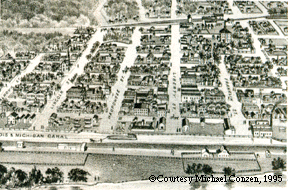 Location, location: Towns like Morris, shown in 1881, thrived thanks to the Illinois & Michigan Canal.
Location, location: Towns like Morris, shown in 1881, thrived thanks to the Illinois & Michigan Canal.
EXPLORER LOUIS JOLLIET POINTED it out in 1673: If not for a single,
100-mile stretch of land, people and goods could travel easily by boat from
the Great Lakes to the Gulf of Mexico. In 1848 his vision was realized when
the Illinois & Michigan Canal opened, joining Lake Michigan to the Illinois
River and, through it, to the Mississippi and the Gulf. The I & M Canal,
says historical geographer Michael Conzen, was America's "last big canal
that made a difference. The difference it made was Chicago."
Today, the region along the former canal is an outdoor laboratory for
Conzen's College and graduate students. A professor and chair of the
committee on geographical studies, he uses the landscape and towns to
illustrate the role geography has played in American history.
In the case of the I & M Canal, which stretched west from Chicago to
LaSalle-Peru, that role was enormous. "Most people think the railroads
catapulted Chicago," says Conzen, "but they came later." In the canal's
first six years, an industrial corridor sprang up along the waterway, which
"articulated the whole upper Midwest as a region." Trade that had flowed
south to New Orleans now went east to Chicago -- a trend only reinforced, he
explains, when the railroads arrived.
Dotted with small towns every few miles, the canal region is rich in
history. "Thoreau, Mark Twain -- all these luminaries came through the I & M
Canal corridor on speaking tours," notes Conzen. "Ottawa is the site of the
first Lincoln-Douglas debate." His students explore the area through
research projects chosen from a list that Conzen prepares, each year
focusing on different towns -- Joliet or Lockport, for example -- or issues,
such as settlement patterns or the industrial revolution. The corridor's
proximity to Chicago, he says, creates an "extraordinary" teaching
resource. "We can easily drive there to explore archives, to meet people,
to collect information, to look at the landscape."
The benefits flow two ways. For the past eight years, Conzen has edited
and published the best of each class's research papers in a series, Studies
on the Illinois & Michigan Canal Corridor. What is usually the students'
first scholarly publication is often the first geographical survey of a
particular town or regional historical development -- an information gap that
prompted the series after local librarians "begged" for copies of the
students' final papers.
In the years since the I & M Canal closed in 1933 -- it was largely
outmoded when the much wider Chicago Sanitary & Ship Canal opened in 1900,
and some sections are today completely dry -- many nearby factory jobs
disappeared. But, in 1984, the region received a boost when it was
designated the country's first National Heritage Corridor, arousing
interest in preserving its history and in how, through tourism, that
history could help local economies.
Conzen, who assisted the groups that lobbied for National Heritage
Corridor status, says that these trends have made his students' research
more and more valuable. Already the papers have been cited in both
scholarly footnotes and efforts to place sites on the National Register of
Historic Places. Before Conzen began the series, he says, "The students
wrote papers and they ended up in my file cabinet." Now, the work has found
its own sense of place.
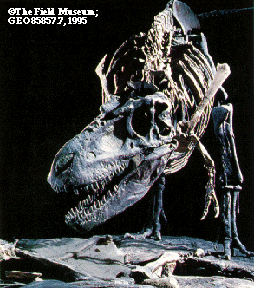
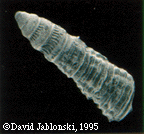 Mystery killer: Why did the event that wiped out Albertosaurus and other dinosaurs spare snails like Cerithiella?
Mystery killer: Why did the event that wiped out Albertosaurus and other dinosaurs spare snails like Cerithiella?
Pity the poor dinosaurs. Falling asteroids, lava-spewing volcanoes, rising
sea levels, and global cooling: In the collective notebooks of scientists,
T. rex and company have suffered their share of calamities. What
force really killed off the dinosaurs 65 million years ago? The popular
whodunit is part of the larger mystery of mass extinctions, the cataclysmic
events that radically changed the course of evolution at least five times.
Their case is far from solved, but, in a trio of recent studies, Chicago
researchers have turned up several new leads, possibly ruling out some
suspects in the mass extinction that wiped out dinosaurs and countless
other species.
What David Jablonski calls a "brutal" picture of that famous
late-Cretaceous event comes from a new census of marine fossils that he
conducted with David Raup, SB'53, the Sewell L. Avery distinguished service
professor emeritus. The Chicago paleontologists compared survival rates of
organisms from that period to see if any earlier adaptations -- in body size
or feeding habits, for example -- helped them to survive the catastrophe.
Surprisingly, nothing did.
"There really was nowhere to hide," says Jablonski, a professor of
geophysical sciences. "What we ordinarily think of as mechanisms for
survival just didn't work."
Because of the study's size and subjects -- 350 lineages of marine
mollusks, whose fossils are abundant and widespread -- its results provide a
good yardstick for how other creatures fared. Organisms with a better
chance for survival were those which, like mollusks, were distributed over
many continents. That finding is consistent, he and Raup believe, with
evidence that dinosaurs as a group were widespread, but specific dinosaur
species were not.
Their study "doesn't tell us whether it was an asteroid or a volcano"
that caused the extinction, says Jablonski, "but it does constrain some of
the killing mechanisms." For example, theories that blame a die-off among
plankton don't square with the fact that plankton-feeding mollusks fared no
worse than their bottom-feeding cousins.
Another clue to the nature of the "killing mechanisms" comes from
geophysical-sciences graduate student Paul Markwick, who has surveyed
late-Cretaceous crocodile fossils as part of the U of C's Paleogeographic
Atlas Project. Because these cold-blooded animals require mild
temperatures, Markwick's finding -- that crocs remained numerous and
widespread after the mass extinction -- disputes the notion that a severe
climate change killed the dinosaurs. "The cooling may have had a part,"
says Markwick, "but it clearly wasn't the major player."
So how could cooling fit in? The mechanisms behind two popular theories,
an asteroid impact and volcanism, both include a short-term cooling, and
the source of that cooling -- blocked sunlight -- would also stop
photosynthesis, causing a breakdown in the food chain, a breakdown that
would hit dinosaurs hard. A cold-blooded crocodile, says Markwick, "could
go kill a wildebeest, and that would keep it happy for the whole year,"
while a presumably warm-blooded dinosaur would need a constant source of
food.
Then the dinosaurs starved to death? "It's not that neat and clear," he
says. Other warm-blooded animals survived the extinction -- namely
mammals.
Enter a new star suspect. David Schramm believes that the
asteroid-impact theory, proposed in 1980 by a group including Luis Alvarez,
SB'32, SM'34, PhD'36, is by now "rather nicely established." But he doubts
if it can explain other mass extinctions, especially given estimates of the
late- Cretaceous asteroid's unusually huge size: 5 kilometers across. A
cosmologist, Schramm wondered if other astronomical events could be
among the culprits. Last year, he and John Ellis of the European
Organization for Nuclear Research updated a theory from the 1970s: Was a
nearby supernova to blame?
Schramm, the Louis Block professor in physical sciences, says radiation
from an exploding star could destroy the Earth's ozone layer for hundreds
of years, leaving phytoplankton and plants unprotected against ultraviolet
light. Then "our own sun does the killing" -- as if the ozone hole now over
Antarctica suddenly expanded to cover the globe -- and the food chain
crumbles from the bottom up.
Using new data on nearby supernovae, Schramm and Ellis also note an
interesting coincidence between their best guess for local supernovae
rates -- one event every few hundred million years -- and the age of the
granddaddy of all mass extinctions: the one that ended the Permian period
some 185 million years before the dinosaurs bit the late-Cretaceous
dust.
Depending on your view, it's scary or amazing or both. And genetics will
soon become a lot more so. Imagine, for example, an amniocentesis test that
screens for dozens of genetic disorders -- instead of a mere handful.
Laying a foundation for this coming knowledge boom is the mammoth Human
Genome Project, biomedicine's $3-billion, ongoing effort to chart the
location and chemical sequence of every single gene on the human
chromosomes. Amid talk of the project's wonderful progress, some
geneticists worry that a discussion of its ethical implications is getting
short shrift.
Mary Mahowald's concerns started when she noticed how official
descriptions of the Human Genome Project made careful use of gender-neutral
language. A medical ethicist and professor of obstetrics and gynecology at
the U of C, she wondered, would the project's impact really be so
impartial?
Couples, Mahowald points out, don't undergo amniocentesis, abortion, or
prenatal treatment of a fetus. Women do. And when a child is born with a
genetic condition, a woman is usually the caregiver. In the context of
these differences, she says, "gender-neutral language is a mistake. It
masks the fact that real differences result in real inequities or
disadvantages."
Differences related to reproduction and caregiving, she believes, are
crucial areas for understanding the impact of the Human Genome Project. A
notion of "gender justice," Mahowald said at a spring conference she
organized on "The New Genetics: Implications for Women," may help society
negotiate a thicket of new genetic dilemmas without turning physical
differences into inequities. Because those differences make complete
equality impossible, she says, gender justice instead means making fairness
the goal.
Before a Swift Hall audience, she explained the idea through examples
like recessive genetic disorders -- sickle-cell anemia and cystic fibrosis
are among the most common -- which can affect children only when both parents
are carriers. What if a pregnant mother, fearing the presence of such a
disorder, asks for a fetal diagnosis when her partner has refused to take
the blood test to see if he's a carrier? That means subjecting the fetus to
the risks of an amniocentesis -- unnecessarily, if the father doesn't carry
the gene. If the test goes ahead, a positive diagnosis would confirm that
both parents are carriers -- notifying the father who had preferred not to
know.
As part of a three-year study she led on women and the Human Genome
Project, Mahowald, assistant director of the University's MacLean Center
for Clinical Medical Ethics, asked other genetics experts whether they
would allow the amniocentesis in such a case. Some wouldn't, believing that
it could undermine the family structure, while others, arguing that a
woman's autonomy extends to the fetus, thought amniocentesis should be
allowed.
From the viewpoint of gender justice, Mahowald argued, the latter was
correct: Health-care professionals should permit the test, because -- while
the decision would treat women and men unequally -- the test's burden and
risks fall more on the woman than on her partner.
Some gender inequities, of course, are socially created. In the future,
Mahowald warned, insurers might prefer to provide differential coverage for
women depending on their predisposition to pass on particular abnormalities
to their children, as revealed by genetic diagnosis. Important new
services -- like a test for the recently identified gene for hereditary
breast cancer -- might be covered by private health insurance if a woman's
family history indicated an elevated risk, but not covered by public
aid.
"Gender justice," Mahowald concluded, "means identifying gender
differences and taking account of them, so as to maximize equality." If her
predominantly female audience was any indication, society may not yet be
equally attuned to that need.
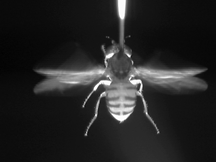
Fancy Flight. This summer, think before you swat. Those flies
dive-bombing your picnic are "the F-16s of the animal world," raves Chicago
biologist Michael Dickinson, "capable of spectacular aerial
maneuvers." As with the jet fighter, there's a steep price involved: Flight
requires up to 100 times the energy of an animal at rest. It's long been
suspected that to achieve this marvel of engineering, insects must have
either some means of recycling the energy spent in each wing stroke or
super-efficient muscles. Yet the fruit fly, Dickinson and University of
Utah colleague John Lighton reported in the April 7 Science, has
only ordinary efficiency in its wing muscles. Instead, by constructing a
tiny flight simulator for flies ("Investigations," February/93), they
discovered that the insect captures some of the inertial power of its wing
motion by stretching an elastic storage mechanism -- the nature of which
remains uncertain.

Unscientific Americans. True or false: If the warning symbol says
it's radioactive, then it must be made by humans. Or try this: All
man-made chemicals cause cancer if you eat enough of them. Both statements
are false, but that's news to many Americans. In a survey by the
National Opinion Research Center at the U of C, one of three people
agreed with the first statement and one of two believed the second.
Overall, Americans had difficulty with the 12-question test of
environmental and scientific knowledge, averaging only 6.6 correct answers.
That placed the U.S. seventh among 20 nations in the survey. A score of
just 7.6 was enough to put Canada in first place, while former communist
countries ranked near the bottom. Americans, though, were dead last when it
came to a question on evolution: Only 48 percent said that humans developed
from earlier species.
Minimum Wager. It's a perennial political debate that bloomed early
this spring in Washington: Should the government raise the minimum wage?
Naysayers in Congress have long argued that a higher minimum will force
businesses to cut jobs, but economists now question that thinking. Indeed,
many believe that the Clinton administration's proposed 75-cent hike in the
wage, to $5 an hour, would cause few, if any, job losses. Not so fast, say
Graduate School of Business economist Kevin Murphy and colleagues at
Texas A & M University. Alone among recent studies, their look at past
minimum-wage increases and employment data found good support for the
traditional wisdom. In contrast to White House claims, they calculate that
a 75-cent raise in the wage would lead to pink slips for roughly 60,000
workers.
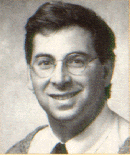
Third Time's the Charm. Millions of children take Ritalin to treat
attention deficit hyperactivity disorder (ADHD), yet surprisingly little
research has considered the drug's optimal dosing. Now, a study by Mark
Stein of the U of C Medical Center shows that three daily doses
of Ritalin -- not the usual two -- may substantially reduce ADHD symptoms, such
as difficulty concentrating or impulsive behavior. Stein found little
evidence to support pediatricians' fears concerning a third, afternoon
dose: that side effects like insomnia or irritability would increase in
incidence. In fact, the only side effect that worsened was a slight loss in
appetite. Though his study was small, its results, says Stein, suggest
prescribing a third dose if a child's symptoms are severe enough to disrupt
late-afternoon activities such as homework, chores, and play with friends
or family.
Written and compiled by Andrew Campbell.
Return to June 1995 Table of Contents

 The University of Chicago Magazine June 1995
The University of Chicago Magazine June 1995
 The facts at hand: Kris Hammond's new program puts Internet wisdom within reach.
The facts at hand: Kris Hammond's new program puts Internet wisdom within reach. Location, location: Towns like Morris, shown in 1881, thrived thanks to the Illinois & Michigan Canal.
Location, location: Towns like Morris, shown in 1881, thrived thanks to the Illinois & Michigan Canal.
 Mystery killer: Why did the event that wiped out Albertosaurus and other dinosaurs spare snails like Cerithiella?
Mystery killer: Why did the event that wiped out Albertosaurus and other dinosaurs spare snails like Cerithiella?
